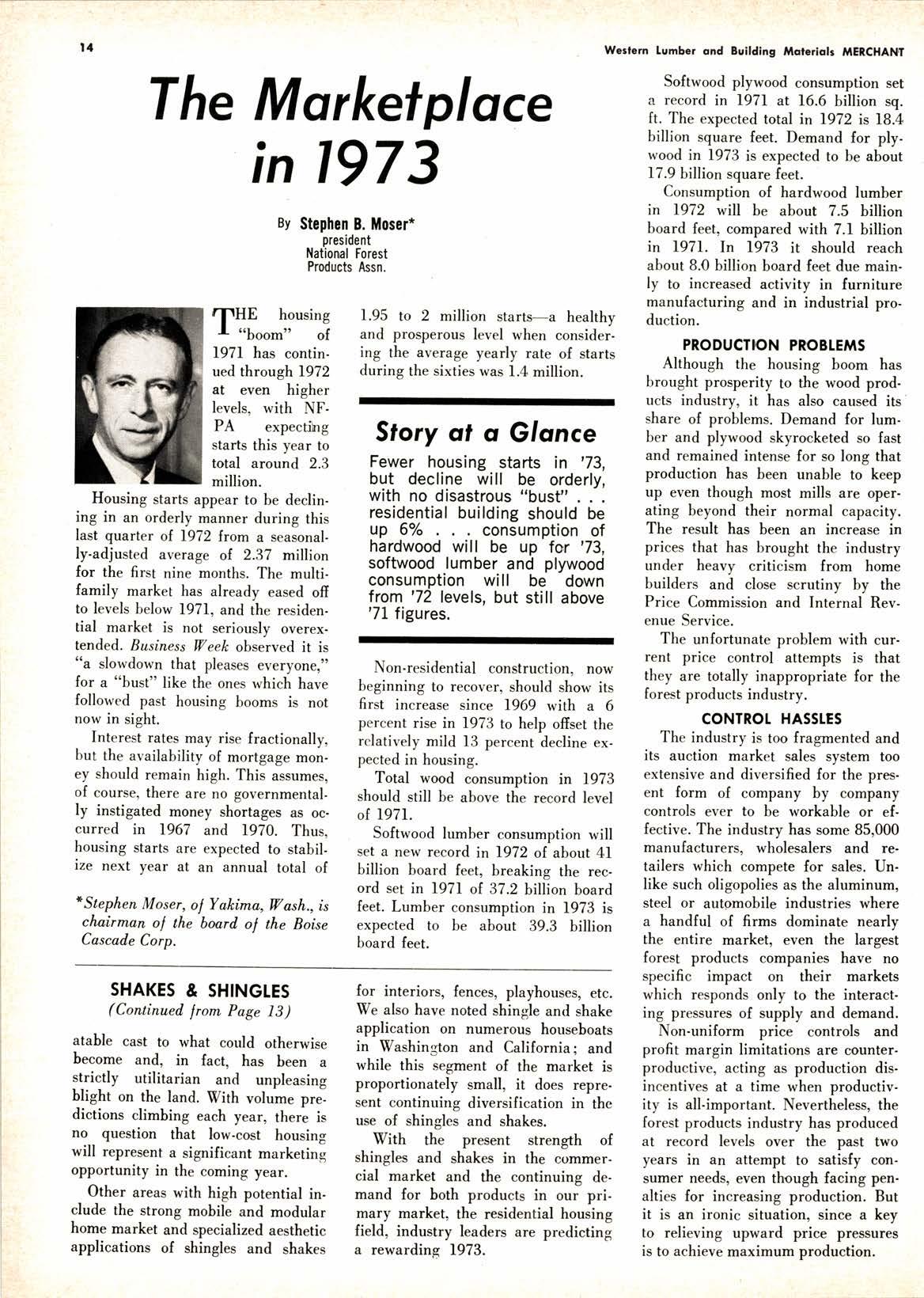
4 minute read
The Msrketploce in 1973
By Stephen B. Moser* president Nationa,l Forest Products Assn.
Softwood plywood consumption set a record in l97l at 16.6 billion sq. ft. The expected total in 1972 is I8.4 billion square feet. Demand for plywood in 1973 is expected to be about 17.9 billion square feet.
Consumption of hardwood lumber in 1972 will be about 7.5 billion board feet, compared with 7.I billion in 197I. In 1973 it should reach about 8.0 billion board feet due main. ly to increased activity in furniture manufacturing and in industrial production.
Production Probteaiis
Story dl d Glonce
THE housing 1.95 to 2 million starrs-a healthy r "boom" of and prosperous level when consider1971 has contin- ing the average yearly rate of starts ued through 1972 during the sixties was 1.4 million. at even higher levels, with NF. PA expectfrrg starts this year to total around 2.3 million.
Housing starts appear to be declining in an orderly manner during this last quarter of 1972 from a seasonal. ly-adjusted average oI 2.37 million for the first nine months. The multifamily market has already eased ofi to levels below 1971, and the residential market is not seriously overex. tended. Business Week observed it is "a slowdown that pleases everyone," for a "bust" like the ones which have followed past housing booms is not now in sight.
Interest rates may rise fractionally, but the availability of mortgage money should remain high. This assumes, of course, there are no governmental. Iy instigated money shortages as oc. curred in 1967 and 1970. Thus. housing starts are expected to stabil. ize next year at an annual total of
*
SHAKES & SHINGTES
(Continueil lrom Page IJ) atable cast to what could otherwise become and, in fact, has been a strictly utilitarian and unpleasing blight on the land. With volume predictions climbing each year, there is no question that low-cost housing will represent a significant marketing opportunity in the coming year.
Other areas with high potential in. clude the strong mobile and modular home market and specialized aesthetic aPPlications of shingles and shakes for interiors, fences, playhouses, etc. We also have noted shingle and shake application on numerous houseboats in Washington and California; and while this seplment of the market is proportionately small, it does repre. sent continuing diversification in the use of shingles and shakes.
Fewer housing starts in '73, but decline will be orderly, with no disastrous "busf' . . residential building should be up 60/o . consumption of hardwood will be up for '73, softwood lumber and plywood consumption will be doirrn trom'72 levels, but still above '71 figures.
Non-residential construction, now beginning to recover, should show its first increase since 1969 with a 6 percent rise in 1973 to help offset the relatively mild 13 percent decline expected in housing.
Total wood consumption in 1973 should still be above the record level of 1971.
Softwood lumber consumption will set a new record in L972 ol about 4I billion board feet, breaking the record set in l97I ol 37.2 billion board feet. Lumber consumption in 1973 is expected to be about 39.3 billion board feet.
With the present strength of shingles and shakes in the commercial market and the continuing demand for both products in our primary market, the residential housing field, industry leaders are predicting a rewarding 1973.
Although the housing boom has brought prosperity to the wood products industry, it has also caused its share of problems. Demand for lum. ber and plywood skyrocketed so fast and remained intense for so long that production has been unable to keep up even though most mills are operating beyond their normal capacity. The result has been an increase in prices that has brought the industry under heavy criticism from home builders and close scrutiny by the Price Commission and Internal Revenue Service.
The unfortunate problem with current price control attempts is that they are totally inappropriate for the forest products industry.
Controt Hasstes
The industry is too fragmented and its auction market sales system too extensive and diversified for the present form of company by company controls ever to be workable or effective. The industry has some 85,000 manufacturers, wholesalers and re. tailers which compete for sales. Un. like such oligopolies as the aluminum, steel or automobile industries where a handful of firms dominate nearly the entire market, even the largest forest products companies have no specifie impact on their markets which responds only to the interacting pressures of supply and demand.
Non-uniform price controls and profit margin limitations are @unterproductive, acting as production dis. incentives at a time when productivity is all-important. Nevertheless, the forest products industry has produced at record levels over the past two years in an attempt to satisfy consumer needs, even though facing penalties for increasing production. But it is an ironic situation, since a key to relieving upward price pressures is to achieve maximum production.

TABTE IALK (1) between exec. vp. of LASC Wayne Gardner and Stan Brown. 0) Bill Hor. muth, Leon Lauderbach, Tim Timmerman. (3) John Lipani 0eft) making presentation t0 Kathrine and Stuart Hanis. (4) Seth potter, Gordon Woolard, Bus Blanchard, John Xelley. 6) Ken Raney, Ray Hayes. (6) Claude Curry. (7) Eill Rau, Doug Maple, Gawain Logsdon. (8) Sun Handling Dock's noble charity iffort
L^ ZOn INCREASE in registrations a \ and full-house attendance at busi. ness meetings marked the Lumber Association of Southern California,s recent 22nd annual Managemenl Conference as the retail-wholesale group conferred about ongoing industry problems in supply, e.olJgy, OSHA and other areas,
Outgoing president Leon Lauder. bach opened the three dav late No- 'vember meet with " ,"pri." of the busy association year just completed, noting the net gain of l0 new retail division members.
Current president of the West Coast Lumber Inspection Bureau, John Kelley, of Arcata, Ca., then discussed WCLIB's long history of quality control and its increased importance in an age of growing consumerism. He forecast that consumerism will eventually change the "quality standards and our way of doing business.,'
Ample money for housing, though perhaps at slightly higher cost, was foreseen by Robert Morgan, president of the California Mortgage Bankers Assn., though he noted that most all construction within the state is now under a cloud because of the newly passed law (Proposition 20) on .nvironmental impact. He feels it will take a long period to fully clarify the new law. t'They're gonna getcha," warned insuranceman John Holdren about OSHA's new stepped-up drive to increase inspections. Some places have been visited twice; penaliies, in extreme cases, can go up to $10,000 per violation. He advised developing and enforcing a safety p.og.r--u.rd keeping track of it to see all follow through.
Inspectors in southern California have been "reasonabler" he said, and cooperation will help any inspection. When buying new-equipment, Holdren counseled, specify on the pur-










